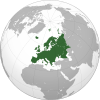Flag of Belarus
The national flag of Belarus is an unequal red-green bicolour with a red-on-white ornament pattern placed at the hoist (staff) end.
Changes made to the Soviet-era flag were the removal of communist symbols – the hammer and sickle and the red star – as well as the reversal of the colours in the ornament pattern.
An additional vertical red-on-white traditional Belarusian decorative pattern, which occupies one-ninth of the flag's length, is placed against the flagstaff.
[1] The flag does not differ significantly from the flag of the Byelorussian Soviet Socialist Republic (Byelorussian SSR), other than the removal of the hammer and sickle and the red star, as well as the reversal of red and white in the hoist pattern, from white-on-red to red-on-white.
[7][8] The pattern, derived from local plants and flowers, is a traditional type commonly used in Belarus.
These patterns are sometimes used in woven garments, most importantly in the traditional ruchnik, a woven cloth used for ceremonial events such as religious services, weddings, and other more minor social functions, such as a host offering guests bread and salt served on a ručnik.
[9][10] The husband of Matrona Markevich was arrested for anti-Soviet propaganda and executed during Soviet repression in Belarus in 1937, after which the family was dekulakised.
The brother of Matrona Markevich, Mikhail Katsar, head of the ethnography and folklore department at the Academy of Sciences of Belarus, was included into the commission that was ordered to create a new flag for the Belarusian SSR in 1951.
[13] On special occasions, such as memorial services and family holidays, and it can be used at ceremonies and events hosted by public organisations, companies, and NGOs.
After the formation of the Byelorussian SSR, the lettering ССРБ (SSRB) was added in gold to the top hoist.
[23] The flag was slightly modified in 1956 when construction details were added for the red star and the golden hammer and sickle.
A pattern of white drawn on red decorated the hoist portion of the flag; this design is often used on Belarusian traditional costumes.
The hammer represented the worker, and the sickle the peasant; according to Soviet ideology, these two symbols crossed together symbolised co-operation between the two classes.
[26][27] Opposition parties claimed that only 48.7% of the entire voting population (75.1% of the 64.7% who showed at the polling stations) supported the adoption of the new flag, but Belarusian law (as in many other countries) states that only a majority of voters is needed to decide on a referendum issue.
[28][29] Upon the results going in favor of President Lukashenko, he proclaimed that the return of the Soviet-style flag brought a sense of youth and pleasant memories to the nation.
On the reverse of the flag, the centre contains the symbol of the armed forces, which is a red star surrounded by a wreath of oak and laurel.


 The white-red-white flag of the
Belarusian People's Republic
(1918), the
Byelorussian SSR
(1990–1991), the
Republic of Belarus
(1991–1995).
The white-red-white flag of the
Belarusian People's Republic
(1918), the
Byelorussian SSR
(1990–1991), the
Republic of Belarus
(1991–1995).


 Flag of the Byelorussian Soviet Socialist Republic, 1951 to 1991
Flag of the Byelorussian Soviet Socialist Republic, 1951 to 1991



